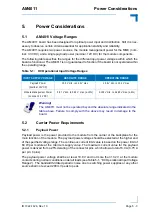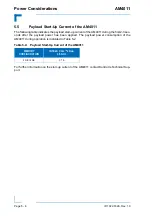
Thermal Considerations
AM4011
Page 6 - 6
ID 1022-1626, Rev. 1.0
P R E L I M I N A R Y
6.1.3.3
Thermal Monitor 1 (TM1)
The Thermal Monitor 1 (TM1) Sensor controls the processor temperature and power consump-
tion by activating the Thermal Control Circuit (TCC) when the processor silicon reaches its
maximum operating temperature.
When TM1 is enabled and a high temperature situation exists, the processor frequency is re-
duced and the event is reported via an external signal to the Module Management Controller.
Once the temperature has dropped below the maximum operating temperature, the Thermal
Control Circuit goes inactive.
The temperature at which TM1 activates the Thermal Control Circuit is neither user-config-
urable nor software-visible.
TM1 does not require any additional hardware, software drivers, or interrupt handling routines.
This function can be enabled and disabled in the BIOS.
6.1.3.4
Thermal Monitor 2 (TM2)
The Thermal Monitor 2 (TM2) Sensor controls the processor temperature and power consump-
tion by activating the Intel® SpeedStep® function when the processor silicon reaches its max-
imum operating temperature.
When TM2 is enabled and a high temperature situation exists, the processor will perform an
Enhanced Intel® SpeedStep® Technology transition to a lower operating point and reports the
event via an external signal to the Module Management Controller. In this case, the processor
reduces its operating frequency and processor core voltage. This combination of reduced fre-
quency and core voltage results in a reduction of the processor power consumption. If the pro-
cessor temperature drops below the critical temperature level, the processor will make an
Enhanced Intel® SpeedStep® Technology transition to the last requested operating point.
The temperature at which TM2 activates the Intel® SpeedStep® function is neither user-con-
figurable nor software-visible.
TM2 does not require any additional hardware, software drivers, or interrupt handling routines.
This function can be enabled and disabled in the BIOS.
6.1.3.5
Catastrophic Cooling Failure Sensor
The Catastrophic Cooling Failure Sensor protects the processor from catastrophic overheating.
The Catastrophic Cooling Failure Sensor threshold is set well above the normal operating tem-
perature to ensure that there are no false trips. The processor will stop all executions when the
junction temperature exceeds approximately 125°C. Once activated, the event remains
latched until the AM4011 undergoes a power-on restart (all power off and then on again).
Note ...
When the ULED3 on the front panel is lit red after boot-up, it indicates that the
processor die temperature is above 100°C.
Note ...
When the ULED3 on the front panel is lit red after boot-up, it indicates that the
processor die temperature is above 100°C.







































